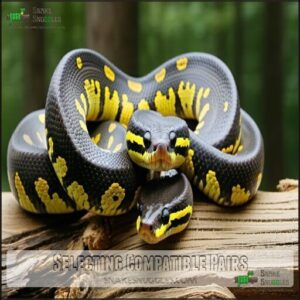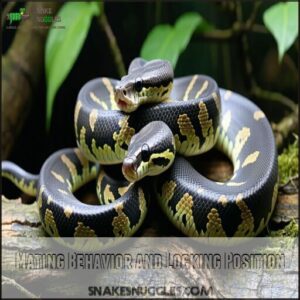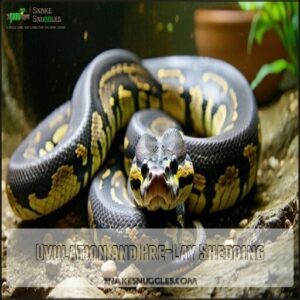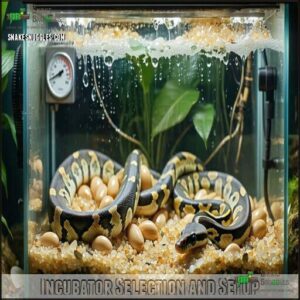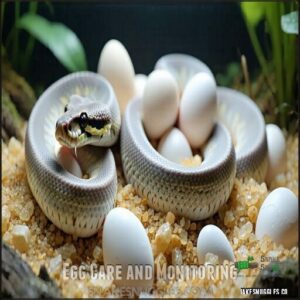This site is supported by our readers. We may earn a commission, at no cost to you, if you purchase through links.

Males often flick their spurs during mating, and a visible “lock” confirms they’ve paired successfully.
Later, the female may refuse food—a common sign of ovulation—and spend extra time coiled tightly, sometimes in her water bowl.
Another key milestone is the pre-lay shed, a distinctive shed occurring 3-4 weeks before egg-laying.
If you’re seeing these signs, stay patient and keep their environment cozy and stable.
There’s nothing quite like watching nature do its thing—your next challenge will be caring for those eggs!
Table Of Contents
Key Takeaways
- You’ll know a pair has successfully bred when a “lock” is visible, with tails intertwined for up to 48 hours.
- Females show signs like refusing food, curling tightly in their water bowl, and experiencing ovulation with noticeable abdominal swelling.
- The pre-lay shed happens 3-4 weeks before egg-laying, signaling breeding success and upcoming clutch preparation.
- Stable temperatures, adjusted humidity, and gradual cooling help mimic natural seasonal cues, boosting breeding success.
Ball Python Breeding Preparation
Preparing for ball python breeding means ensuring your snakes meet specific health, age, and weight requirements.
Ensuring your ball pythons are healthy, mature, and at ideal weight is the key to successful breeding.
Focus on proper nutrition, enclosure setup, and careful environmental adjustments to set the stage for success.
Female Weight Requirements
How do you guarantee success in ball python breeding? Start with females meeting proper weight requirements.
A minimum weight of 1,200 grams is essential for breeding health and avoiding risks like egg-binding.
Aim for ideal weight with these steps:
- Encourage gradual weight gain over months.
- Avoid obesity risks with balanced feeding.
- Monitor weight regularly using a digital scale.
Male Weight Requirements
Male ball pythons need a suitable weight of at least 700 grams for breeding readiness. This guarantees sperm viability and supports their genetic contribution.
Monitor weight, as underweight males may show reduced breeding signs. Consistent feeding and environmental care are health indicators.
Pairing healthy males means better outcomes for ball python breeding. The following table outlines the relationship between weight and breeding success:
| Weight (grams) | Readiness | Health Indicators | Breeding Success |
|---|---|---|---|
| 1000 | Ideal | Active breeding | Excellent |
Age and Maturity Factors
Age maturity plays a key role in ball python breeding.
Males typically reach sexual maturity by 18 months, while females need two to three years and at least 1,200 grams to breed safely.
Rushing first-time breeders can harm reproductive lifespan and genetic health.
Waiting for proper female maturity guarantees healthy clutches, reducing risks and improving breeding signs for lasting success.
Pre-Breeding Diet and Nutrition
A solid pre-breeding diet boosts female weight and male energy. Gradually adjust feeding frequency to meet weight requirements without overfeeding.
Offer diverse prey varieties to build proper fat reserves for females and energy for males. Smart supplement strategies guarantee balanced nutrition.
Hatchlings thrive later with strong foundations, so early diet adjustments matter. Keep meals consistent; small changes make big impacts.
Females benefit from reaching minimum weight requirements before breeding, which is crucial for a successful breeding program with proper fat reserves.
Selecting Compatible Pairs
Choosing the right pair is essential for healthy offspring and successful breeding. Focus on age, weight, and genetic traits to guarantee compatibility and avoid common issues.
Genetic Outcomes and Morph Variability
How do you access incredible genetic outcomes from your ball pythons? It starts with understanding morph inheritance and gene expression.
Focus on recessive traits like albino or piebald for unique results.
- Pair for novel mutations and unusual morphs.
- Avoid problematic spider morphs due to potential issues.
- Study polygenic traits for subtle genetic traits.
- Track genetic mutations for your breeding plans.
Breeding Statistics and Success Rates
Understanding ball python breeding success starts with numbers.
Fertility rates hover around 64% naturally, while assisted methods boost it to 75%.
Hatch rates reach 70-80%, depending on care.
Healthy clutch size links to breeding age—females over 2 years and 1,200g thrive.
Genetic health also matters; good matches reduce hatchling mortality and avoid traits influencing future breeding statistics.
Proper ventilation helps to maintain snake health, which is crucial for breeding success and overall snake health.
Common Breeding Mistakes and Solutions
Breeding challenges often stem from pairing unreadiness or environmental stress.
Overbreeding females, pairing mistakes, or neglecting genetic problems can hurt breeding success factors.
Common mistakes like incubation errors or poor monitoring of male energy lead to hatchling issues.
Always prioritize breeding readiness—test incubators early, allow recovery time between breeding, and stick with strong morph combinations to guarantee healthier outcomes.
Breeding Season Timing
Timing your ball python’s breeding season is key to ensuring reproductive success, as it mimics their natural environment.
By aligning with seasonal cues like cooler temperatures and adjusted light cycles, you’ll create the ideal conditions for mating, which is crucial for reproductive success.
Natural Seasonal Cues
Why is timing everything in ball python breeding? Their breeding season aligns with Africa’s rainy season, providing natural cues.
To mimic this:
- Adjust light cycles for shorter days and longer nights.
- Use brumation mimicry with gradual temperature cycling.
- Replicate seasonal changes with consistent habitat replication.
- Start pre-breeding preparations in September for ideal timing.
Nature’s rhythm boosts python breeding success!
Temperature and Humidity Management
Proper temperature and humidity management is vital.
Use thermal gradients to mimic natural environments, with a daytime temperature range of 88-90°F and nighttime drops to 76-78°F.
Sphagnum moss benefits humidity balance; maintain 50-60% with hydrometer calibration.
Regular temperature cycling guarantees stability.
Understanding snake breeding season is key to reproductive success.
A consistent setup prevents shedding issues and fosters reproductive success.
| Factor | Ideal Range | Tools Needed |
|---|---|---|
| Day Temp | 88-90°F | Precise Thermostat |
| Night Temp | 76-78°F | Thermal Gradient Setup |
| Humidity Levels | 50-60% | Hydrometer Calibration |
The use of thermal gradients and maintaining the right humidity levels is crucial for the health of the snakes.
Proper temperature management is also essential for preventing shedding issues.
Consistency in the setup is vital for the snakes’ overall well-being and breeding success.
Gradual Cooling and Brumation Effects
Lowering enclosure temperatures carefully can mimic nature’s seasonal changes, boosting ball python breeding.
Cooling schedules, though optional, promote brumation benefits like better fertility. Gradual temperature cycling prevents stress and reduces health risks, helping trigger successful breeding signs.
Humidity’s role matters too—monitor closely to avoid shedding issues. Mimicking nature often produces noticeable brumation effects, improving overall python breeding success.
Breeding Process Signs
When breeding ball pythons, recognizing key signs like mating behavior, locking, and ovulation is essential for determining success.
Observing these indicators helps you confirm your snakes are progressing through each stage of reproduction smoothly, which is crucial for reproduction.
Mating Behavior and Locking Position
Spotting python mating behavior starts with courtship displays, like males pressing their bellies against females.
Mating begins with subtle courtship cues, like males gently pressing their bellies against receptive females.
Once receptive, females allow hemipene insertion, leading to the locking position. Lock duration usually spans 4 to 48 hours.
- Signs of locking: intertwined tails.
- Typical mating signs: still pairs.
- Pairing attempts: often needed.
- Sperm storage: allows delayed fertilization.
- Multiple pairings: boosts success.
Ovulation and Pre-Lay Shedding
You’ll notice key ovulation signs like abdominal swelling and visible ridges as eggs grow.
Shed timing varies, but a prelay shed often happens 16-30 days after ovulation.
Watch for changes in gravid behavior, like increased heat-seeking or reduced appetite.
Follicle size matters, and females often store sperm for weeks, ensuring a healthy ovulation cycle and successful breeding.
Successful Mating Indicators
After ovulation and the pre-lay shed, successful ball python mating signs become clear.
A locking position is key—tails entwined for 4-48 hours. Females can store sperm for weeks, boosting chances of fertilization.
Look for a gravid appearance and these python breeding signs:
- Locking duration lasting several hours
- A receptive female, still during locks
- Swelling, hinting at ovulation signs
Incubation and Hatching Success
Proper incubation and hatching are vital for turning healthy eggs into thriving hatchlings.
You’ll need a reliable incubator setup, steady temperature and humidity control, and careful monitoring to guarantee success.
Incubator Selection and Setup
Choose an incubator with proper size, temperature stability, and humidity control.
Reliable ventilation prevents mold, while a suitable substrate avoids excess moisture.
Verify the incubator temperature stays between 88–90°F with steady conditions.
Many breeders purchase a specialized reptile incubator for this purpose.
DIY setups can use water trays to stabilize heat.
Always test the setup before egg incubation to guarantee ideal incubation conditions for healthy development and ensure the incubator temperature is stable, which is crucial for successful breeding with a specialized reptile incubator.
Egg Care and Monitoring
Maintaining proper incubation conditions is critical.
Keep incubator temperature steady at 88°F and humidity levels at 90-100%.
Use moist incubation substrates to prevent egg dehydration.
Monitor eggs weekly with egg candling to check embryo growth, removing infertile ones.
Optimal humidity is vital for successful hatching.
Any shift in temperature stability can cause hatchling problems, so double-check settings regularly.
Consistent attention guarantees healthy development and hatchling care.
Hatching and Post-Hatch Care
Once eggs hatch, shift your focus to hatchling care. Set up proper hatchling enclosures with warmth, humidity, and ample hides.
Address shedding issues promptly to guarantee healthy hatchlings. Monitor growth regularly and prepare for their first feeding within a week.
Ethical sourcing of food supports hatchling development. Consistent care guarantees these newcomers thrive, laying the foundation for robust adult ball pythons.
Setting up the appropriate snake habitat is vital for their well-being.
Frequently Asked Questions (FAQs)
How to reduce stress during breeding attempts?
Think of stress as a quiet storm; calm it with stable temperatures, soft handling, and a familiar environment.
Provide hides, monitor humidity, and avoid overhandling to keep your pythons relaxed during breeding attempts.
Can breeding affect female ball python lifespan?
Breeding can reduce a female ball python’s lifespan if done excessively, as it strains her body.
Proper care, rest periods, and maintaining her health between seasons help guarantee she remains strong and reproduces safely over time.
What causes a female to reject a male?
Sometimes, a female ball python "gives the cold shoulder" to a male due to stress, improper temperatures, or being underweight.
Pairing too early or male aggression can also reduce her willingness to mate, which can be a result of the female being underweight.
Are multiple males beneficial in breeding plans?
Using multiple males can increase genetic diversity and improve pairing success, especially if one male isn’t receptive.
Rotate males to avoid stress and guarantee they’re rested between breedings for maximum fertility and health.
How do environmental changes impact breeding success?
Adjusting temperatures and humidity mimics nature, signaling it’s time to breed.
Cool nights, stable daytime warmth, and slight shifts in humidity push your pythons into reproductive readiness, creating a cozy, rain-forest vibe they instinctively trust, which is crucial for their reproductive cycle.
Conclusion
Picture your female ball python coiled snugly, a sign of successful breeding efforts and nature’s rhythm unfolding.
By watching for clear ball python breeding signs—like locking behavior, ovulation, and the pre-lay shed—you’ll feel confident in your progress.
Keep conditions stable, monitor her behavior, and provide the perfect nesting environment.
Success in ball python breeding isn’t instant, but with patience and attention to detail, you’re on track to welcome healthy eggs and hatchlings into the world, which is the ultimate reward of successful breeding efforts.
- https://community.morphmarket.com/t/breeding-schedules-ball-pythons/32972
- https://www.reddit.com/r/ballpython/comments/bpeyf4/can_some_explain_how_to_know_if_your_female_will/
- https://www.americanmadeexotics.com/breeding-ball-pythons-article.html
- https://www.youtube.com/watch?v=93cktCQXiYM&pp=0gcJCfcAhR29_xXO
- https://en.wikipedia.org/wiki/Ball_python


